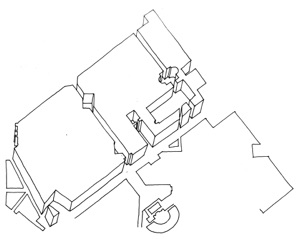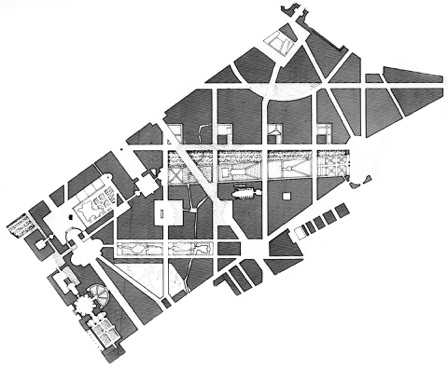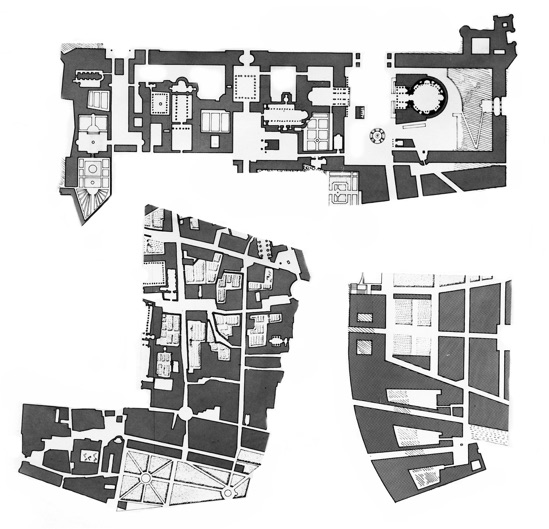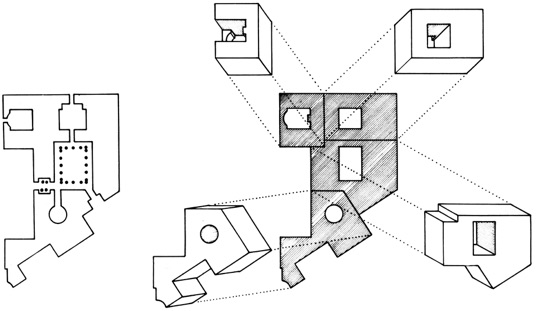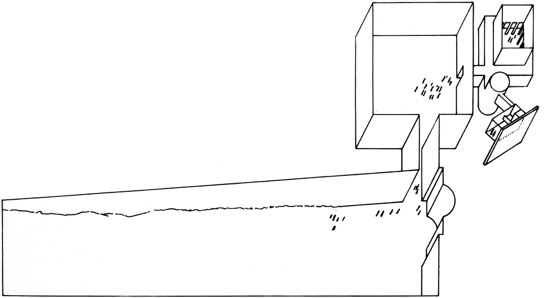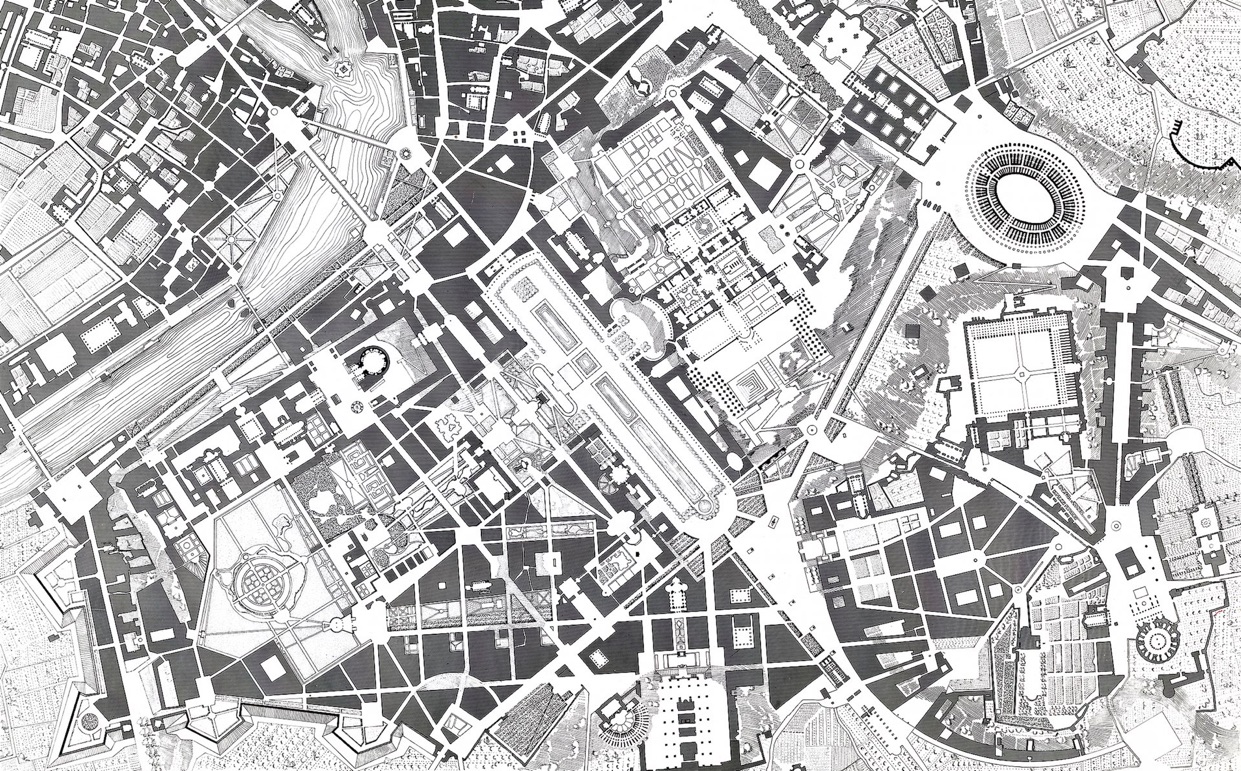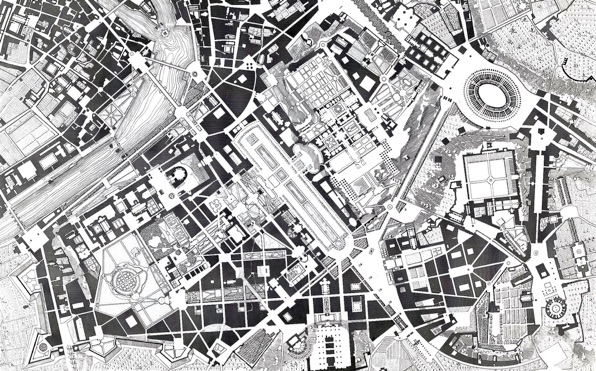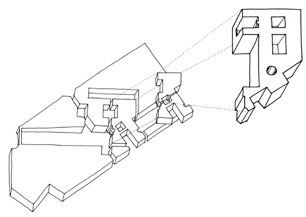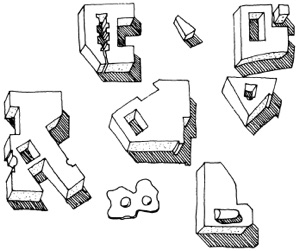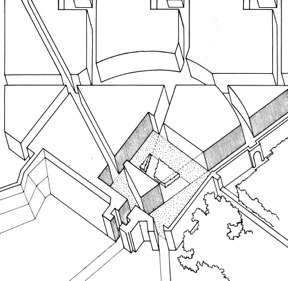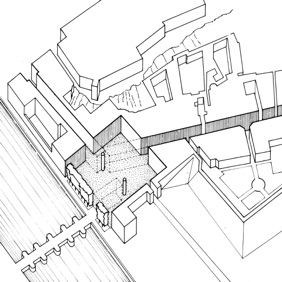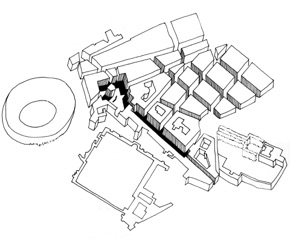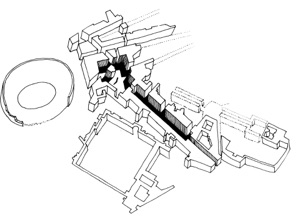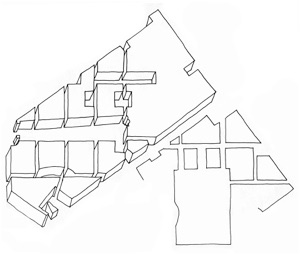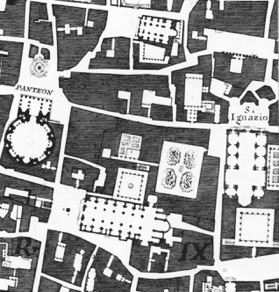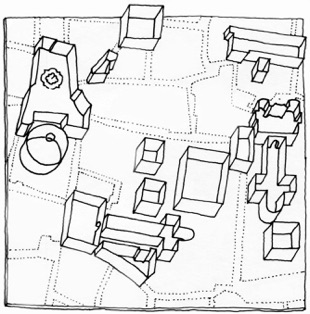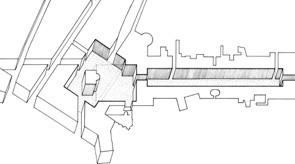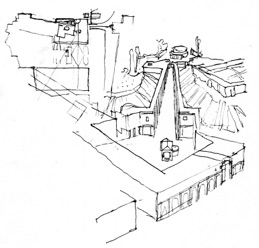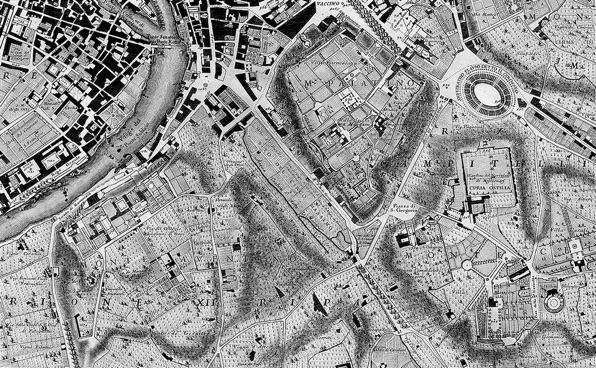URBAN DESIGN TACTICS
STEVEN PETERSON
THE ROMA INTERROTTA EXHIBITION:
and Urban Design Tactics
This article was written for Architectural Design Magazine which documented the Exhibition “ROMA INTERROTTA", held in 1978 at Trajan’s Market in Rome, Italy. It describes the formal elements and compositional methods that were developed in the design of the Nolli Sector VIII map assigned to Colin Rowe.1.
The overall plan strategy of the project was: to extend the Nolli urban fabric, to show how the empty southern hill spaces could be occupied as an urban extension of the central city, and to use the quintessential spatial structure of the Nolli map. See the “before and after” plans of the map sector to the left.
To achieve this, a variety of formal tactics were employed and explored in the final design plan. These tactics are identified and explained in the article with the implication that they are also categories of formal order applicable to the urban design of all cities.
The project is a kind of poetic composition of change in space at different times, with an invented plan of evolving growth connected to an invented history of places and events. (Click to read Colin Rowe’s commentary) It looks almost finished, like a master plan, but it is incomplete, a map of fragments “in progress” as starting points for later additions. Note the areas around the Colosseum, east of the Celio Hill, south of the fortifications and even on top of the Aventine.
The existing conditions plan shows that, urban Rome had not yet reached south into the empty hills, vineyards and villas in 1748. Even today, this aerial photo shows the area is a scattered mix of disconnected sprawl.
BEFORE: Existing conditions surrounding the Circus Maximus shown on the Nolli Plan of Rome in 1748
AFTER: Urban Design Proposal for the Colin Rowe sector of the Roma Interrotta Exhibition of 1978
1.The final design plan for Roma Interrotta was completed by Colin Rowe and Steven Peterson and incorporated the separate proposals for the top of the Palatine Hill by Peter Carl and for the top of the Aventine by Judy DiMaio.
1) 2) In Nolli, figural space as a positive volume generates the urban medium.
5000 pixels
TODAY: Aerial photo of the Nolli site sector VIII from Apple Maps
So,the question posed by the exhibition and addressed by the article is:
-
What is Urban Design?
Urban Elements
Delineation of the elements deriving from space begins with the most characteristic aspect of the city, which is not the isolated space itself nor the block as object, but the combined fabric of both, extended over an entire area in an associated larger group form. When this area is recognizable and coherent it is defined as a “Field”. Its subsidiary elements are Texture, Street and Square, Block and Block unit. Each of these elements, including the field, can be designed and manipulated in a corresponding relationship between plan and perceptual experience.
The Field is an area of the city that has distinct defining characteristics, achieved through clear edge, clear center, or distinct texture (figure 3).
It is mosaic in form, non-linear, non-axial, repetitive, continuous and possibly disordered. It has the design qualities of fabric or surface (figure 4, figure 5); its edges can be shaped; its inner area inscribed with pattern; it can be joined with other fields, overlapped and interwoven. As an aggregate formal entity it sometimes corresponds to districts or neighborhoods.
-
4)The field inscribed with orthogonal spaces.
-
5)The field composed of a diagonal gridded texture corresponding to terrain.
-
3) A field defined by distinct edge and texture.
The Streets and Squares are the principal elements formed from the urban medium of space. They are definitive and specific, constituting the active compositional elements of the field. The street is linear, axial, open and continuous (a cul-de-sac is not a street). It is the ordering element that connects through the city, beyond any local field, as well as the essential constant strand of local texture. The square has the opposite characteristics of street: it is centralized, closed and discontinuous. It acts as a spatial variable linked by the streets into the field. The square, with its variety of possible configurations, ranges from a central place of identity and focus (figure 7, figure 8, figure 9, figure 10), to a peripheral receptacle of mixture and transitions (figure 11, figure 12).
The Texture is the basic matrix material of the city. It is characterized by the combined pattern of streets, squares, and blocks, whose variations range in a continuum of typological orders from the gridded to random. The variables of texture are degree of regularity, proportion of solid to void, and density. It has aspects of scale and repetitiveness, depending on the frequency and type of streets and blocks; it has grain and directionality depending on relative street widths and orientations (figure 6). The modern, or anti-space city texture does not provide as many variables and is limited to frequency and rhythm.
-
6)Three illustrations of texture with varying degrees of regularity, scale, and proportion of solid to void. One contains no blocks but an assembly of large buildings, another is a transformed block system, and the third is a random pattern overlaid with regular lines.
-
7)A complex linkage of spaces leading to St Stefano Rotondo from the Coliseum; the main Piazza is an overlap of two squares corresponding to different directions of movement.
-
8)View up to hilltop.
-
10)It can generate a gridded field of blocks to the side.
-
9)A sequence of urban spaces is also an armature for growth.
-
11)A regular space serves as a stable receptacle terminating a series of influences.
-
12)A complex, multiple space acts as an overlapping joint between two fields and generates its own radiating effect back into the texture.
The Block unit itself is not the nuclear element of the city, but is a composite form made of many discrete subsidiary elements or constituent block units. The typical block, if it is reduced in size to become a single unitary building, will lack the size and adaptability to correspond with external spatial requirements and will disassociate itself from the surrounding texture.
The constituent block unit is the critical element in any urban situation. It is the nuclear constant which stabilizes and counterbalances the peripheral irregularity of the larger block element. The constancy of the block unit is achieved through its definition of a contained inner block space that provides autonomy, structure, and identity in juxtaposition to its associative role as part of a larger group form (figure 15).
The courtyard is the prototypical example of this inner block space, but the French hotel cour d’honneur, the English mews, and the private yard of the townhouse, all serve to provide a degree of nuclear stability cushioning the block’s external irregularity. It is at the scale of the block unit that the variety of transformations to a traditional form, provide a city’s distinct typology. This is the usual extent to which architecture is concerned.
The perception of these combined elements forms the typical urban experience – a linked, sequential variety of spaces which integrate districts and neighborhoods and establish the degrees of public and private realm. The inner block space, acting in a coherent dialogue with the complex fabric of public outer block space, produces the distinctions which frame events, establish place, and provide for the necessary transitions of passage (figure 16). The range of meaning and interpretation associated with these spatial linkages depend on their degree of specificity and articulation.
The Block is the principal constituent physical element of the urban field and texture. As such it is not necessarily a constant, repetitive, modular element, but is itself variable requiring flexibility in size, proportion and perimeter configuration (figure 13). The block is generally not discrete, symmetrical or central, but is multiform, inflective, and peripheral (figure 14).
-
14)The block is a constituent fragment of the field.
-
13)The variety of block configurations and sizes required to form the Aventine field exhibits no uniform repetitive module.
Strategies and Tactics
The exact formal strategies and tactics available to achieve this urban condition are best articulated in the context of a specific situation. The plan for Roma Interrotta provides some examples. On this site, the existing terrain prohibits a unified total design scheme, but a realistic schedule of implementation on any large site also suggests a program of incomplete, juxtaposed developments.
-
15)The block is itself a composite group form with an internal world. The block unit results from a logical division of property, its inner positive space providing an associative structure for the whole block.
-
16)A diagram of the experienced relationship of urban spaces, from public garden into local street, through neighborhood square, into semi-private court, up the stair and into private rooms. Urbanism involves the order of distinctions throughout the entire sequence.
Space: The Medium of Urbanism
The Nolli map epitomizes the basic condition of urbanism. The city of Rome is represented primarily as the interwoven relationship of spaces, incorporating the entire spectrum of sequences that connect the public and semi-public to the private. The space as it is drawn by Nolli is a particular and specific conception that can be interpreted as the positive actuality of volumetric form: the space is more figural than the solids which define it; it is conceived as a positive entity in an integrated relationship with the surrounding solids; it is itself the prerequisite medium from which the whole fabric of urbanism emerges (figure 1, figure 2).
This concept of space as an existent form is prototypical, and the generating ingredient. Its essence or memory are discernible in varying degrees of definition and specificity in every successful urban situation. The exact opposite of this is the modern conception of space as a ubiquitous continuum without form, inhabited by an assembly of autonomous objects. “Modern” space is consequently anti-urban, and in comparison to the space of Nolli, could be called anti-space. See Space and Anti Space
Urban Design
Urban design is a synthetic, inventive mapping of physical conditions that establishes and explores whole areas of the city. In other words, it is architecture – but encompassing more in scale, intention, and technique. Three basic questions of morphology are connected with the discipline of urban design in its examination of the city as a physical entity:
First
Second
Third
What are the constituent urban elements of the city?
What are the formal strategies and tactics available to provide coherence and relationships among the elements?



